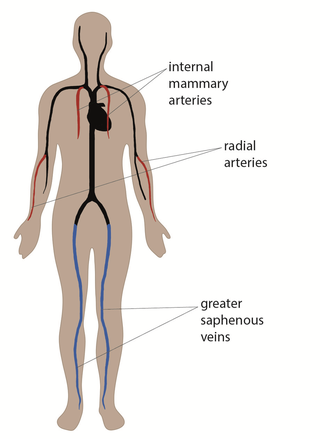A coronary artery bypass graft (CABG) is a surgical procedure. It is used to treat coronary heart disease.
It diverts blood around narrowed or clogged parts of the major arteries. This improves blood flow and oxygen supply to the heart.
Why a CABG is carried out
Like all organs in the body, the heart needs a constant supply of blood. This is supplied by 2 large blood vessels called the left and right coronary arteries.
Over time, these arteries can become narrowed and hardened by the build-up of fatty deposits called plaques. This process is known as atherosclerosis.
People with atherosclerosis of the coronary arteries have coronary heart disease.
Your chances of developing coronary heart disease increase with age.
You're also much more likely to be affected if:
- you smoke
- you're overweight or obese
- you have a high-fat diet
Coronary heart disease can cause angina. This is chest pain caused reduced flow of blood to the heart.
Many cases of angina can be treated with medicine. Severe angina may need a CABG to improve the blood supply to the heart.
Another risk of coronary heart disease is one of the plaques in the coronary artery rupturing. This can create a blood clot. If the blood clot blocks the blood supply to the heart, it can trigger a heart attack.
A CABG will reduce your chances of having a heart attack.
The procedure
A CABG involves taking a blood vessel from another part of the body. This is usually the chest, leg or arm. The blood vessel is attached to the coronary artery above and below the narrowed area or blockage.
This new blood vessel is known as a bypass graft.
The number of bypass grafts needed will depend on how:
- severe your coronary heart disease is
- many of the coronary blood vessels are narrowed
A CABG is done under general anaesthetic. This means you'll be asleep during the operation. It usually takes between 3 and 6 hours.

Recovery
Most people will need to stay in hospital for 5 to 7 days after having a CABG.
You'll have a follow up appointment about 6 to 8 weeks after your operation.
Recovering takes time and everyone recovers at slightly different speeds.
Generally, you should be able to:
- sit in a chair after 1 day
- walk after 3 days
- walk up and down stairs after 5 or 6 days.
When you go home, you'll need to take things easy for a few weeks.
You should be able to return to most of your normal activities after about 6 weeks, including working, driving and having sex.
Most people make a full recovery within 12 weeks.
Risks of surgery
Cardiac surgery is performed for serious medical conditions. Although surgery is beneficial for patients, it does carry a real risk of complications.
There can be temporary complications such as an irregular heartbeat or a wound infection. These may need more treatment and a longer hospital stay. A small number of serious complications can happen with longer term consequences such as stroke.
After surgery
After a CABG, you will see an improvement in your symptoms. You should see an improvement in your breathlessness and chest pain. Your heart attack risk is also lowered.
A CABG is not a cure for coronary heart disease. You will need to make lifestyle changes, such as eating a healthy diet and exercising regularly. If you do not, your grafted arteries will eventually become hardened and narrowed.
In some cases, a CABG may need to be repeated. Or you may need a procedure to widen your arteries using a small balloon and a tube called a stent. This is known as a coronary angioplasty.
Alternatives
A coronary angioplasty is the main alternative to a CABG.
It's a less invasive operation. A long, flexible, hollow plastic tube called a catheter is inserted into a blood vessel in your arm or groin.
The tip of the catheter is guided to the affected artery using an x-ray.
A balloon attached to the catheter is then inflated to widen the artery. A small metal tube called a stent is often used to help keep the artery open.
It usually takes less time to recover from a coronary angioplasty than from a CABG. But there's a higher chance that the procedure will need to be repeated.
A coronary angioplasty may not be recommended if a lot of arteries have become blocked and narrowed. It may also not be recommended if the structure of the blood vessels near your heart is abnormal.
Content supplied by the NHS and adapted for Ireland by the HSE
